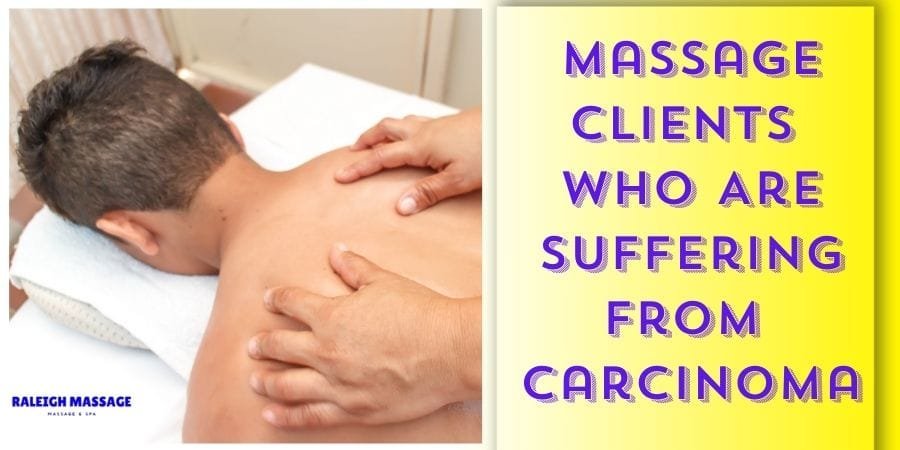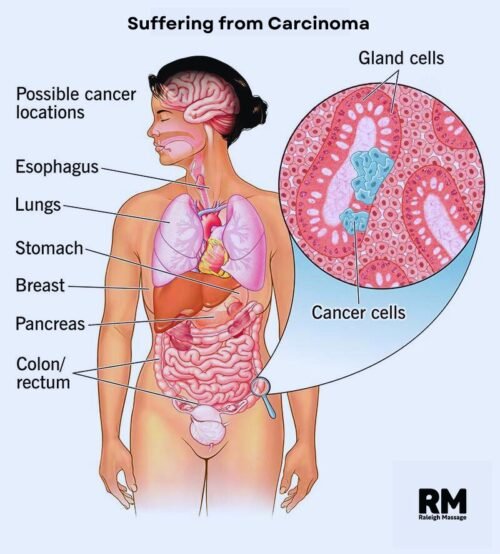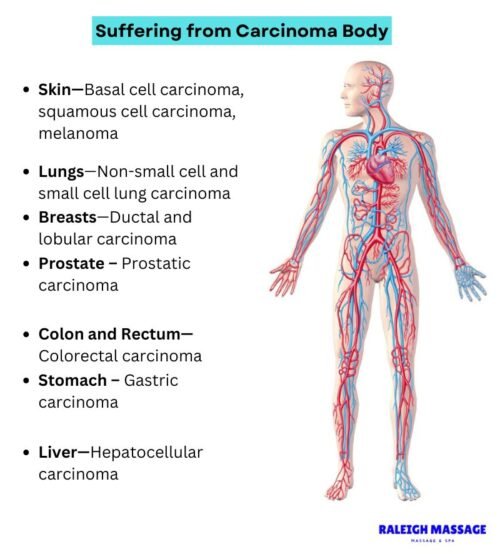Hello, in this blog, we will learn how to do massage clients who are suffering from carcinoma and explain everything you need to know. How can you get rid of it with massage clients for suffering from carcinoma? The whole topic will be discussed.
To attend to carcinoma-afflicted clients, one must not only have skill but patience, sympathy, and a full understanding of their disease. As a massage practitioner, one cannot but wonder about offering care and not causing any form of hurt. I have seen numerous carcinoma-afflicted clients, and I can speak firsthand about a proper touch having a significant impact.
Understanding Carcinoma and Its Impact
A carcinoma is a kind of cancer that originates in organ and tissue lining and in organs and tissue in general, and can arise in any location in the body, with its therapies having secondary consequences. Typical ones include weakness, puffiness, and sensititivity, and pain.
Some of your clients will have been having chemotherapy and radiation, and both of these processes make even minor pressure uncomfortable for them. Others will have had surgery, and have therefore developed scars and sensitive areas. All your clients will differ, and therefore, make a query about their state and comfort level first.
Is Massage Safe for Someone Suffering from Carcinoma?
Many people think massage isn’t safe for cancer patients. That’s not true. When done correctly, it can provide relief. The key is adjusting the pressure and avoiding certain areas. A gentle approach helps improve circulation, reduce stress, and ease pain.
Before massaging someone with carcinoma, consult their doctor. Some cases require special precautions. For example, if they have a tumor, avoid deep pressure near that area. If they have lymphedema, be careful with swollen areas. Safety always comes first.
Best Massage Techniques for Clients with Carcinoma
Not all massages work for cancer patients. Deep tissue and aggressive techniques can cause discomfort. Instead, focus on light, soothing strokes.
This technique is gentle and relaxing. Soft strokes help with circulation and reduce stress. I use long, flowing movements to ease tension without putting pressure on sensitive areas.
- Lymphatic Drainage
Cancer treatments often lead to fluid buildup. This technique helps drain excess fluid, reducing swelling. It requires soft, rhythmic strokes that encourage lymph flow. If your client has lymphedema, avoid massaging directly over the swollen area.
- Reflexology
Sometimes, direct contact with the affected area isn’t possible. Reflexology is a great alternative. It involves applying gentle pressure to specific points on the feet and hands. This can help reduce pain and promote relaxation.
Adapting the Massage to Each Client
Every client has different needs. Some may prefer a shorter session, while others need extra support to get comfortable. Always ask about their pain level and make adjustments. I often use pillows and bolsters to provide extra support. Positioning matters. If lying flat is uncomfortable, try a semi-reclined position.
If a client has sensitive skin due to radiation or medication, choose hypoallergenic oils or creams. Avoid scented products, as they can trigger nausea in those undergoing treatment.
Emotional Support Matters
A massage is more than just physical relief. For someone suffering from carcinoma, it can be an emotional experience. Many clients feel anxious or depressed. A safe, compassionate space helps them relax.
I always take my time. I let my clients talk if they want to. Sometimes, they need to share their fears or frustrations. Simply listening can be just as healing as the massage itself.
When to Avoid Massage
There are times when massage isn’t safe. If a client has a fever, blood clots, open wounds, or extreme fatigue, avoid massaging them. Always check with their doctor if you’re unsure. It’s better to be safe than sorry.
Final Thoughts
Massaging clients suffering from carcinoma takes sensitivity and care. A gentle touch can bring comfort, reduce pain, and improve well-being. Always adapt your approach based on their needs.
If you’re looking for compassionate massage therapy in Raleigh, visitRaleigh Massage. Your comfort and well-being matter.
FAQs
1. Can massage transmit carcinoma in clients with carcinoma?
Massage will not make cancer metastasize. That is a myth. Massage, when conducted in a proper manner, can stimulate circulation, ease tension, and promote comfort. However, therapists should not use deep tissue over a tumor and inflamed tissue. Obtain a doctor’s permission first when working with a client with a malignancy.
2. What is the most beneficial massage for carcinoma clients?
Gentle techniques like Swedish massage, lymphatic drainage, and reflexology are best. These help with relaxation, pain relief, and circulation without putting stress on the body. Avoid deep tissue or aggressive pressure. Always adjust the massage based on the client’s comfort level.
3. Do I use oils or lotions when I massage a carcinoma client?
Yes, but use hypoallergenic and unscented ones. Chemotherapy drugs make your skin sensitive, and strong ingredients can then become a source of irritation. Ask your client first about their skin and allergy, and then use any product.
4. Can chemotherapy symptoms be eased with massage?
Yes, it can. Clients can become nausea, exhausted, and tense during therapy. Gentle massage can calm them out. Reflexology and soft Swedish massage go perfectly with it. First, make a consultation with their doctor, though.
4. Can chemotherapy symptoms be eased with massage?
Yes, it can. Clients can become nausea, exhausted, and tense during therapy. Gentle massage can calm them out. Reflexology and soft Swedish massage go perfectly with it. First, make a consultation with their doctor, though.
5. How do I ensure my client feels safe and comfortable during the massage?
Communication is paramount. Ask them about their level of pain, comfort, and medical concerns first. Position them with pillows and bolsters for support. Have a peaceful and relaxing session. Let them stop and make any changes when and if they choose, and respond with concern and care.









